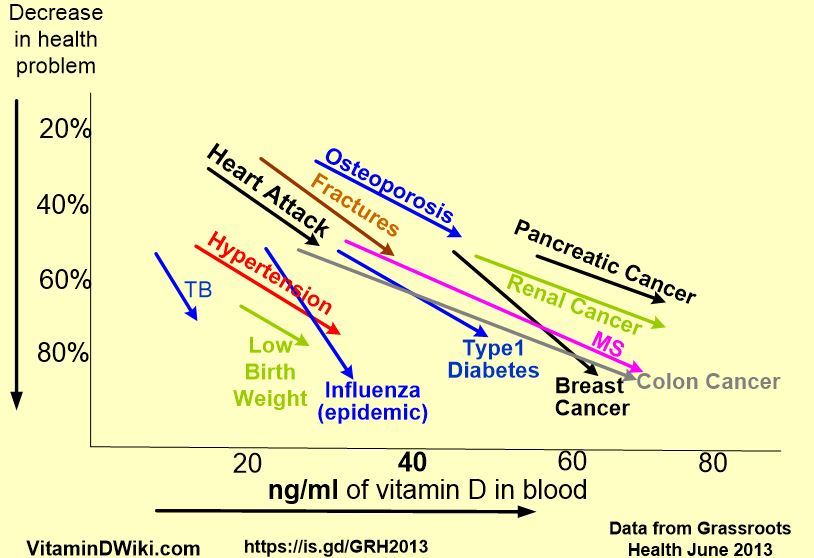Liver cancer half as likely if high level of vitamin D
Pre-diagnostic circulating vitamin D levels and risk of hepatocellular carcinoma in European populations: A nested case-control study
Hepatology DOI: 10.1002/hep.27079
Veronika Fedirko1, Email: vfedirk@emory.edu,, Talita Duarte-Salles2, Christina Bamia3, Antonia Trichopoulou3,4, Krasimira Aleksandrova5, Dimitrios Trichopoulos4,6,7, Elisabeth Trepo8, Anne Tjønneland9, Anja Olsen9, Kim Overvad10, Marie-Christine Boutron-Ruault11,12, Françoise Clavel-Chapelon11,12, Marina Kvaskoff11,12, Tilman Kühn13, Annie Lukanova13, Heiner Boeing5, Brian Buijsse5, Eleni Klinaki4, Chrysanthi Tsimakidi4, Alessio Naccarati14, Giovanna Tagliabue15, Salvatore Panico16, Rosario Tumino17, Domenico Palli18, H.Bas Bueno-de-Mesquita19,20,21, Peter D. Siersema20, Petra H. Peters22, Eiliv Lund23, Magritt Brustad23, Karina Standahl Olsen23, Elisabete Weiderpass Vainio23,24,25,26, Raul Zamora27, María-José Sánchez28,29,30, Eva Ardanaz29,31, Pilar Amiano32, Carmen Navarro29,33,34, J.Ramón Quirós35, Mårten Werner36,37, Malin Sund38, Björn Lindkvist39, Johan Malm40, Ruth C Travis41, Kay-Tee Khaw42, Magdalena Stepien2, Augustin Scalbert2, Isabelle Romieu2, Pagona Lagiou3,6, Elio Riboli43, Mazda Jenab2,*
The association between vitamin D status and hepatocellular carcinoma has not been well investigated, despite experimental evidence supporting an important role of vitamin D in liver pathophysiology. Our objective was to investigate the association between pre-diagnostic circulating 25-hydroxyvitamin D [25(OH)D] serum levels and risk of hepatocellular carcinoma in a prospective, nested case-control study among 520,000 participants in the European Prospective Investigation into Cancer and Nutrition (EPIC) cohort.
Each case (n = 138) diagnosed between 1992 and 2010 was matched to one control by age, sex, study center, date and time of blood collection, and fasting status. Serum baseline levels of 25(OH)D were measured by liquid chromatography/tandem mass spectrometry. Multivariable incident rate ratios (IRR) of hepatocellular carcinoma associated with continuous (per 10 nmol/L) or categorical levels (tertiles or a priori-defined categories) of pre-diagnostic 25(OH)D.
Higher 25(OH)D levels were associated with a 49% reduction in the risk of hepatocellular carcinoma (highest vs. lowest tertile: multivariable IRR = 0.51, 95% confidence interval, 0.26 to 0.99; Ptrend= 0.04; per 10 nmol/L increase: IRR = 0.80, 95% confidence interval, 0.68-0.94).
The finding did not vary substantially by time from enrolment to diagnosis, and did not change after adjustment for biomarkers of pre-existing liver damage, nor chronic infection with hepatitis B or C viruses. The findings were not modified by body size or smoking status.
Conclusion: In this prospective study on Western European populations, serum levels of 25(OH)D were inversely associated with risk of hepatocellular carcinoma. Given the rising incidence of this cancer in low-risk developed countries and the strong public health interest surrounding the potentially cancer-protective roles of vitamin D, additional studies in different populations are required.
Funded by
French National Cancer Institute (L'Institut National du Cancer; INCA). Grant Number: 2009-139
European Commission (DG-SANCO)
International Agency for Research on Cancer
Danish Cancer Society (Denmark)
Hellenic Health Foundation (Greece)
Italian Association for Research on Cancer (AIRC)
National Research Council
LK Research Funds
Dutch Prevention Funds
World Cancer Research Fund (WCRF)
European Research Council (ERC). Grant Number: ERC-2009-AdG 232997
Health Research Fund (FIS)
Regional Governments of Andalucía, Asturias, Basque Country, Murcia. Grant Number: 6236
ISCIII RETIC(Spain). Grant Number: RD06/0020
British Heart Foundation
See also VitaminDWiki
Liver category listing has items along with related searches
Liver cancer nicely treated by high dose vitamin D for 16 weeks (early stage, in rats) – April 2018
Search VitaminDWiki for "LIVER CANCER" 140 items as of April 2018
Strong association of non alcoholic fatty liver disease and low vitamin D non alcoholic fatty liver disease can result in liver cancer
Overview Cancer and vitamin D which has the following chart (no data on Liver Cancer, but you get the idea)

